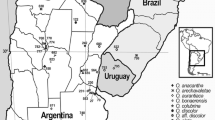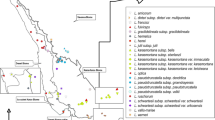Abstract
The genusCheirolophus is a good example of a genus with a western Mediterranean distribution, with an important centre of speciation in Macaronesia. We carried out an electrophoretic study on representatives of Iberian-North African species ofCheirolophus as well as species from the Canaries. In addition, some species of the generaCentaurea, Crupina andSerratula were examined. Our results show high genetic identities between taxa and low genetic diversity inCheirolophus from the Canaries. This is the same pattern found in plants from other oceanic archipelagos and it suggests a recent colonization of the Canaries by the genusCheirolophus. The Iberian species exhibit high genetic identities, suggesting that the genus as a whole is younger than has been suggested. Cluster analysis shows little correlation between accepted taxonomic delimitation of the species ofCheirolophus and isozyme variation, which points towards very recent speciation in the genus; not only in the Canarian species, but also in the continental group. On the other hand, cluster analysis reinforces the segregation ofCheirolophus as a genus distinct fromCentaurea and supports a closer relationship to the genusSerratula.
Similar content being viewed by others
References
Barrett, S. C. H., Shore, J. S., 1990: Isozyme variation in colonizing plants. — InSoltis, D. E., Soltis, P. S., (Eds): Isozymes in plant biology, pp. 107–126. — London: Chapman & Hall.
Boissier, E., 1839–1845: Voyage botanique dans le midi de l'Espagne pendant l'année 1837. — Paris.
Bramwell, D., 1976: The endemic flora of the Canary Islands. Distribution, relationships and phytogeography. — InKunkel, G., (Ed.): Biogeography and ecology in the Canary Islands, pp. 207–240. — The Hague: Junk.
Bremer, K., 1994:Asteraceae. Cladistics and classification. — Portland: Timber Press.
Cassini, H., 1817:Cheirolophus. — Dictionnaire de Sciences Naturelles I: 250. — Paris.
Crawford, D. J., 1990: Enzyme electrophoresis and plant systematics. — InSoltis, D. E., Soltis, P. S., (Eds): Isozymes in plant biology, pp. 146–164. — London: Chapman & Hall.
De Joode, D. R., Wendel, J. F., 1992: Genetic diversity and origin of the Hawaiian Islands cotton,Gossypium tomentosum. — Amer. J. Bot.79: 1311–1319.
Dostál, J., 1975: New nomenclatural combinations and taxa of theCompositae subtribeCentaureinae in Europe. — Bot. J. Linn. Soc.71: 191–210.
Elisens, W. J., 1992: Genetic divergence inGalvezia (Scrophulariaceae): evolutionary and biogeographic relationships among South American and Galápagos species. — Amer. J. Bot.79: 198–206.
, 1988: Genetic variation and differentiation in the genusMabrya (Scrophulariaceae-Antirrhineae): systematic and evolutionary inferences. — Amer. J. Bot.75: 85–96.
Francisco-Ortega, J., Crawford, D. J., Santos-Guerra, A., Sa-Fontinha, S., 1995: Genetic divergence among Mediterranean and Macaronesian genera of the subtribeChrysantheminae (Asteraceae). — Amer. J. Bot.82: 1321–1328.
, 1996: Isozyme differentiation in the endemic genusArgyranthemum (Asteraceae:Anthemideae) in the Macaronesian Islands. — Pl. Syst. Evol.202: 137–152.
Garnatje, T., 1995: Relació entre el polimorfisme enzimàtic i alguns aspectes de l'especiació i de l'evolució en el gènereCheirolophus Cass. — Doctoral Dissertation, Universitat Autònoma de Barcelona.
Gottlieb, L. D., 1981: Electrophoretic evidence and plant populations. — Progr. Phytochem.7: 1–46.
Grant, V., 1981: Plant speciation. — New York: Columbia University Press.
Hamrick, J. L., Linhart, Y. B., Mitton, J. B., 1979: Relationships between life history characteristics and electrophoretically detectable genetic variation in plants. — Annual. Rev. Ecol. Syst.10: 173–200.
Holub, J., 1973: Some new nomenclatural combinations inCentaureinae (Asteraceae). — Preslia45: 142–146.
Kunkel, G., 1992: Flora y vegetación del archipiélago canario. Tratado florístico. 2a part. Dicotiledóneas. — Las Palmas: Edirca.
Lewis, P. O., Crawford, D. J., 1995: Pleistocene refugium endemics exhibit greater allozymic diversity than widespread congeners in the genusPolygonella (Polygonaceae). — Amer. J. Bot.82: 141–149.
Lowrey, T. K., Crawford, D. J., 1985: Allozyme divergence and evolution inTetramolopium (Compositae:Astereae) on the Hawaiian islands. — Syst. Bot.10: 64–72.
Olivares, A., Stübing, G., Peris, J. B., Martín, J., 1995:Cheirolophus lagunae sp. nov. (Asteraceae), endemismo iberolevantino. — Anales Jard. Bot. Madrid53: 262–265.
Rohlf, F. J., 1988: NTSYS-pc Numerical taxonomy and multivariate analysis system, version 1.50. — Setauket, NY: Exeter Publishing.
Soltis, D. E., Soltis, P. S., 1990: Polyploidy, breeding systems, and genetic differentiation in homosporous pteridophytes. — InSoltis, D. E., Soltis, P. S., (Eds): Isozymes in plant biology, pp. 241–258. — London: Chapman & Hall.
Stübing, G., Peris, J. B., Olivares, A., Martín, J., 1997:Cheirolophus mansanetianus Stübing, Peris, Olivares & Martín, sp. nov. andC. grandifolius (Font Quer) comb. & stat. nov. (Asteraceae), two endemics from Spain. — Anales Jard. Bot. Madrid55: 170–173.
Susanna, A., 1989: Mapa 114.Cheirolophus intybaceus (Lam.)Dostál. — InFernández Casas, J., (Ed.): Asientos para un atlas corológico de la flora occidental, 11. — Fontqueria22: 16–18.
, 1991: Mapa 478.Cheirolophus sempervirens Boiss. — InFernández Casas, J., Gamarra, R., (Eds): Asientos para un atlas corológico de la flora occidental, 18. — Fontqueria31: 267–269.
, 1993: Mapa 511.Cheirolophus uliginosus (Brot.)Dostál. — InFernández Casas, J., Morales, M. J., (Eds): Asientos para un atlas corológico de la flora occidental. — Fontqueria36: 208–210.
, 1995: Phylogenetic relationships in tribeCardueae (Asteraceae) based on ITS sequences. — Amer. J. Bot.82: 271–294.
Tanksley, S. D., 1979: An efficient and economic design for starch gel electrophoresis. — Rep. Tomato Genet. Coop.29: 36–38.
Vallejos, C. E., 1983: Enzyme activity staining. — InTanksley, S. D., Orton, T. J., (Eds): Isozymes in plant genetics and breeding. Part A, pp. 469–516. — Amsterdam: Elsevier.
Wagenitz, G., 1955: Pollenmorphologie und Systematik in der GattungCentaurea L. s. l. — Flora142: 213–279.
Author information
Authors and Affiliations
Rights and permissions
About this article
Cite this article
Garnatje, T., Susanna, A. & Messeguer, R. Isozyme studies in the genusCheirolophus (Asteraceae:Cardueae-Centaureinae) in the Iberian Peninsula, North Africa and the Canary Islands. Pl Syst Evol 213, 57–70 (1998). https://doi.org/10.1007/BF00988908
Received:
Revised:
Accepted:
Issue Date:
DOI: https://doi.org/10.1007/BF00988908




